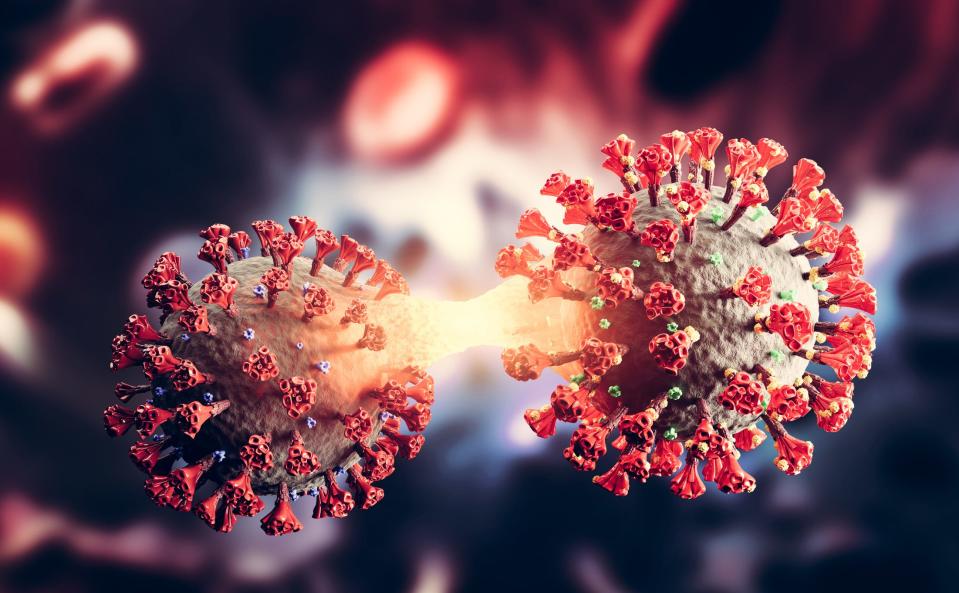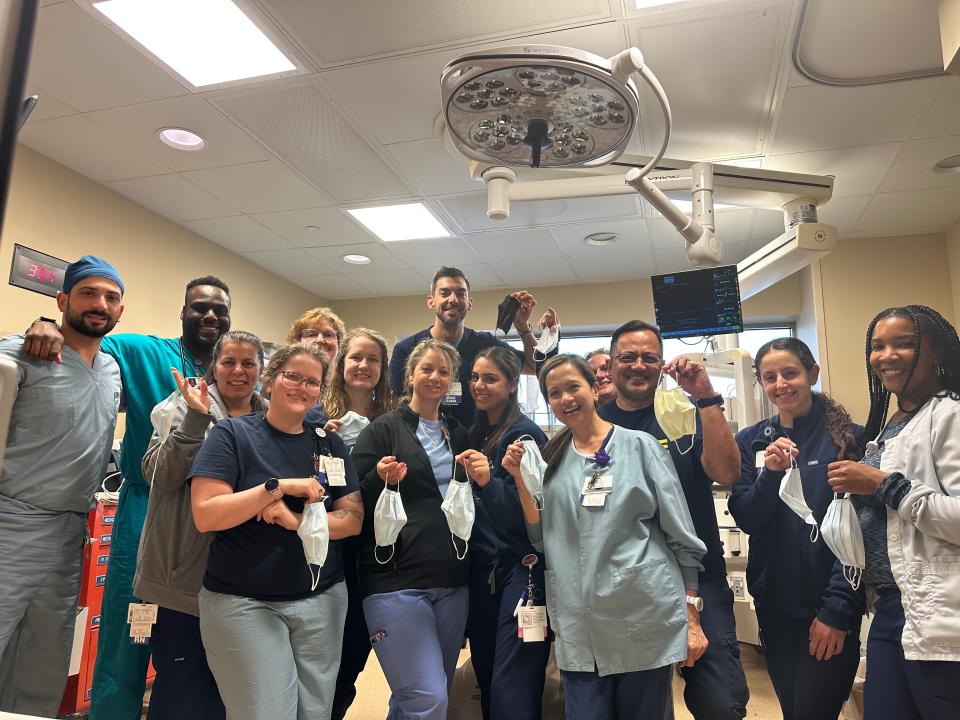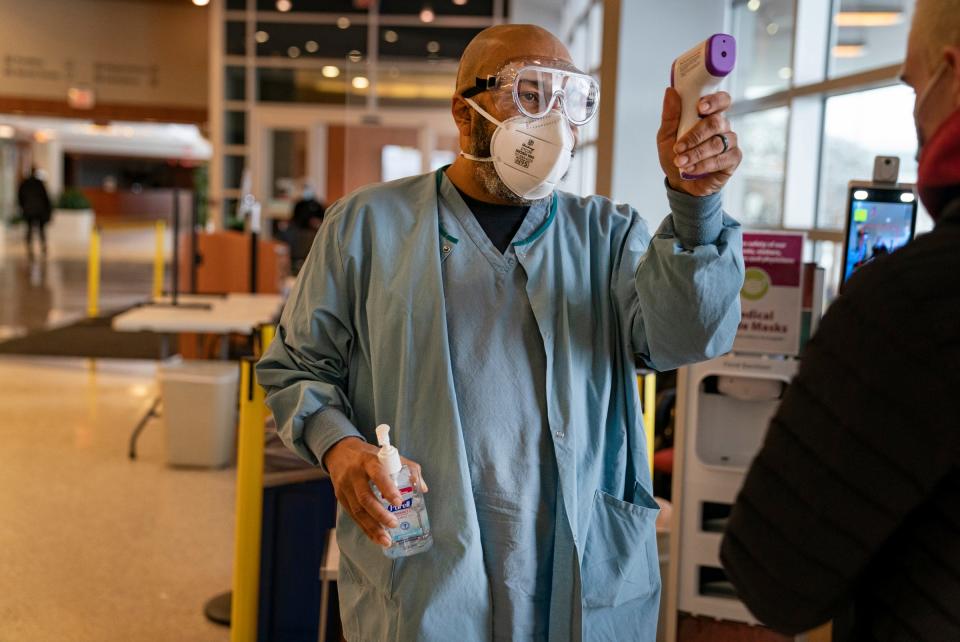First US case of new COVID-19 variant identified in Michigan lab
- Oops!Something went wrong.Please try again later.
Guess who's back, back again? Not that it ever really left us.
COVID-19, the disease caused by the SARS-CoV-2 virus, is on the upswing yet again across the U.S. and in Michigan, where the first U.S. case of a new variant, BA.2.86, was identified earlier this month at the University of Michigan's lab.
While COVID-19 hospitalizations have grown in the past month, the total number is a small fraction of the illnesses during surges.
BA.2.86 has more than 30 new mutations and currently is classified a sublineage of the omicron strain, but has been nicknamed "Pirola" by some scientists. Cases also have been confirmed in Virginia and Ohio, as well as Denmark, the U.K., South Africa and Israel, according to the U.S. Centers for Disease Control and Prevention and the Ohio Department of Health.
How serious is the BA.2.86 variant?
The CDC issued a risk assessment last week, explaining that scientists are working to understand more about what those mutations mean for transmissibility of the virus, severity of disease and whether the new coronavirus vaccine booster, expected to be greenlighted by federal regulators in September, will be effective in preventing severe illness and death from BA.2.86.
"There is concern because there are a lot of mutations in this variant," said Aubree Gordon, associate professor of epidemiology and global public health at the University of Michigan.

"All of the risk assessments for this variant haven't been done yet ... but what we do know at this point is there are a lot of mutations and mutations in some key sites, which may indicate that this virus might be better at evading preexisting immunity than some of the prior variants.
"There's always the concern that there'll be enough immune evasion that you'll start to see people get sicker. That's obviously a big concern — or that we will just get a huge number of cases because more people are getting infected. And, of course, the more infections there are, usually the more severe cases there are."
Still, there remains too little information to draw many major conclusions, said Gordon, who also is the director of the Michigan Center for Infectious Disease Threats and Pandemic Preparedness.
Health news: Widely used diabetes, heart disease, autoimmune drugs for Medicare price negotiation
"We need more data," she said. "We really need to pay attention to this virus, but I think we're in a really different point than we were when omicron came in."

In December 2021 and January 2022, when the original strain of the omicron variant first hit Michigan, a lot of people still had only vaccine-induced immunity to the novel coronavirus. But now, she said, many Michiganders have a broader level of immunity because they've been vaccinated and had a previous infection. They may also have been infected multiple times with different strains of the virus.
"That's going to give them more protection against any incoming variant than just having immunity against the original virus," Gordon said.
What do we know about Michigan's BA.2.86 case?
The first known case in Michigan was identified in an older adult from Washtenaw County who had mild symptoms and was not hospitalized, said Chelsea Wuth, a spokesperson for the Michigan Department of Health and Human Services.
"Based on the available evidence, it is not known yet what risks, if any, this may pose to the public’s health beyond what has been seen with other currently circulating lineages," Wuth said. "We are working with the CDC, which is collaborating with domestic and international partners to gather more information. CDC has not made any changes to their guidance at this time.
"Public health agencies continue to investigate COVID-19 cases and test available specimens to understand the spread of COVID-19 in the population. The University of Michigan and the state of Michigan both sequence COVID-19 viruses to detect new variants, which is how this variant was identified."
No additional cases have been linked to this one, said Susan Ringler-Cerniglia, spokesperson for the Washtenaw County Health Department.
The BA.2.86 case was identified through routine surveillance, she said, and there is no known connection between the person who had the infection and the University of Michigan community.
"Because there were several detections of this variant worldwide at about the same time, it is likely circulating more broadly than we know," Ringler-Cerniglia said.
What's happening with COVID-19 case numbers, hospitalizations?
Michigan — like the rest of the country — is seeing a rise in COVID-19 cases and hospitalizations, though the variant that's causing the most infections right now doesn't appear to be BA.2.86 just yet.
Rather, about 15 different XBB sublineages of the omicron variant are causing about one-third of all known coronavirus infections in Michigan. In addition, cases caused by the EG.5 sublineage are growing in prevalence, making up about 21% of known cases as of Aug. 19, according to state health department data.
Wastewater surveillance shows a higher level of infection statewide, and the number of people hospitalized with COVID-19 in Michigan has more than doubled in the last month — jumping from 102 on July 24 to 237 as of Aug. 25, according to state data.

Still, COVID-19 hospitalizations remain near historic lows for Michigan. By comparison, at the height of the initial omicron surge, about 4,500 people were hospitalized with the virus statewide as emergency departments were overwhelmed with sick patients, and businesses and schools shut down because so many workers and students were sick.
At the time, more than 100 Michiganders were dying every day from the disease. Last week, the state health department reported an average of one daily death from COVID-19.
'We will be seeing new variants all the time'
"We are moving into a place where COVID is more of an endemic disease, and we will be seeing new variants all the time," said Joseph Eisenberg, professor of epidemiology at the University of Michigan School of Public Health. "This is maybe the first endemic season that we are entering. The fall is when the flu kicks in, too, and people are watching very closely what these new variants are doing to get a sense of how bad the COVID season peak will be. Is it going to be like influenza, or how is it going to be different?"
The newly identified BA.2.86 sublineage probably is spreading more widely than testing has identified, he said, and likely is infecting people across Michigan and in other states as well.
"There's probably a fair amount of transmission," Eisenberg said. "It's circulating. And the question is, will it take off or will it not and if it takes off, how severe or virulent will it be? That's the other piece of it because we are going to see waves of lots of transmission. That's just part of life. We are not going to be eradicating COVID. So we want to be able to manage it the best we can, and we want to minimize the impact, minimize the number of severe cases and hospitalizations."
Because BA.2.86 is so different, will rapid tests and current treatments work on it?
Public health leaders believe the current rapid tests and PCR tests will continue to be effective.
However, Eisenberg said, no test is perfect.
"We've all experienced them not being that precise," he said. "We test negative two or three times and finally test positive. The thinking is that they'll be still somewhat useful, and there's no evidence to suggest they're not useful at this point.
The CDC reported last week that treatments like Paxlovid, Veklury and Lagevrio should remain effective against this variant, though monitoring is ongoing.
Will the new COVID-19 booster protect against latest strain?
A CDC subcommittee is to meet on Sept. 12 to consider whether to recommend that Americans should get the newly reformulated coronavirus vaccine booster. And if so, specifically which Americans?
The new booster is a monovalent vaccine, which means it was made to target one variant — the XXB omicron lineage of the virus. It's too soon to know how much protection it will offer against BA.2.86. At the very least, Eisienberg says he hopes it will blunt the severity of infections.
"For influenza, sometimes the vaccine is a good match, but sometimes the efficacy of the influenza vaccine is like 20-30%," he said. "Sometimes, if it's above 50%, people are pretty happy.
"The problem with the current way in which we're developing new vaccines is you're always playing a catch-up game. You're always behind the curve because you can't anticipate this new strain. So you may be lucky that the new strain is not that different from the strains you designed the new vaccine off of. But it just takes so long to develop the vaccine and (ensure all) the safety factors are in place that you're always going to be behind.
"Even if it's not effective in minimizing transmission, it can be effective in minimizing severity. Hopefully, people will get vaccinated and therefore have another layer of protection. Given the technology at this point, that's the best we can do."
Should you get a COVID-19 booster? Here's what you need to know in 2023
Should I go back to wearing a mask or taking other precautions now?
That's a very personal choice, Eisenberg said, adding that if you're a person who is especially vulnerable to COVID-19, "it's never too soon" to mask up in public places.
"You do want to be more careful if you have elderly parents or relatives that are more sensitive," he said.
It's also important to stay home if you're sick and if you must go out when you have respiratory symptoms, wear a mask to protect others, he said.
"It is more acceptable to do that," he said. "It wasn't acceptable to do that pre-COVID, and so that's that's a good thing. ... This is this is a wake-up call that infectious diseases are a part of our lives and we have to learn how to live with it, and manage it.
"We've spent billions and billions of dollars to try and eradicate polio and we're still not there yet. So the eradication game is just not a public health solution. I think we just have to realize that COVID is around and we have to do our best to mitigate it using all sorts of things like improving indoor air quality and ventilation and such.
"We want to invest in prevention and I think this vaccine is one piece of it."
Contact Kristen Shamus: kshamus@freepress.com. Subscribe to the Free Press.
This article originally appeared on Detroit Free Press: First US case of BA.2.86 COVID variant identified in Michigan lab

